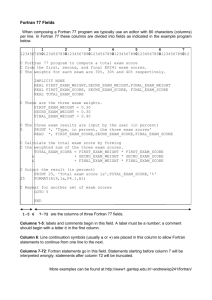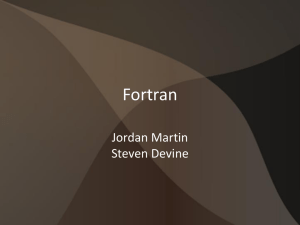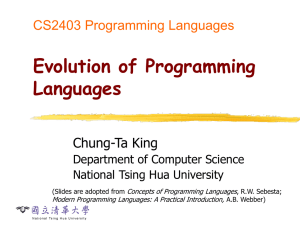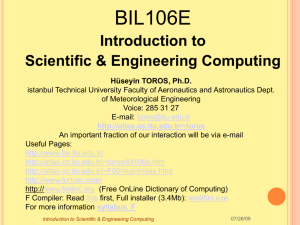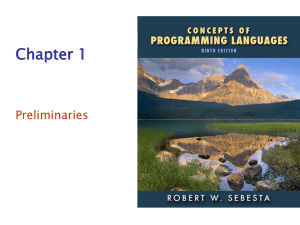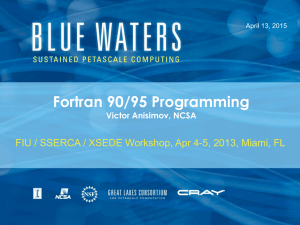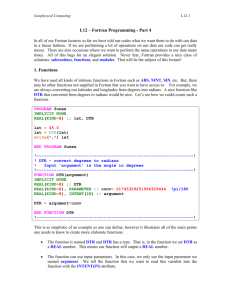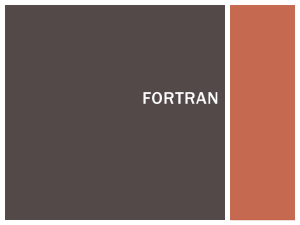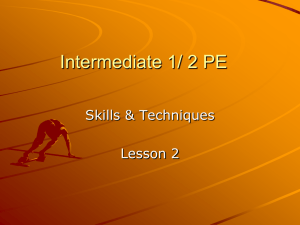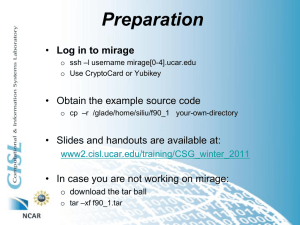Fortran
advertisement
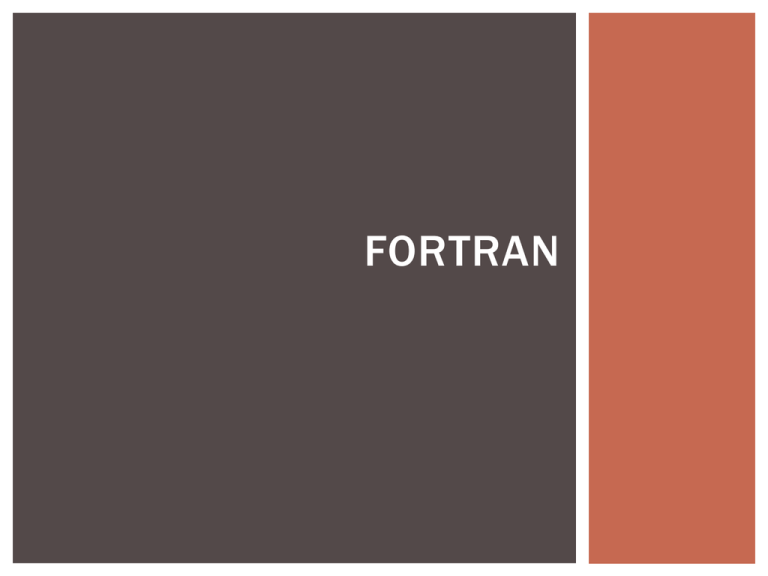
FORTRAN BACKGROUND Fo r t r a n o r FO R m u l a T R A N s l a t i o n wa s d e v e l o p e d i n t h e 1 9 5 0 ' s by I B M a s a n a l te r n a t i v e to Assembly Language. First successfull high level language. FO R T R A N 6 6 First HLL Standard FO R T R A N 77 Character data types Improved Do Loops and If statements Fo r t r a n 9 0 Free format source code Modern control structures Derived Data Types Powerful array notation Dynamic Memory allocation Operator overloading Keyword argument passing The INTENT attribute Control of numeric precision Support for Modules Fo r t r a n 9 5 minor improvements Fo r t r a n 2 0 0 3 Object oriented Fortran Fo r t r a n 2 0 0 8 Concurrent Programming Fo r t r a n 2 01 5 Minor improvements Programming Languages Family Tree DEVELOPMENT ENVIRONMENT Yo u w i l l w a n t to b e c o m fo r t a b l e u s i n g a n tex t - e d i to r l i ke v i o r e m a c s – t h a t s u p p o r t s s y n t a x h i g h l i g h t i n g a n d a u to - i n d e n t a t i o n et c . . . T h e r e i s a n i d e c a l l e d P h o t r a n t h a t I h av e n ev e r u s e d . I p r e f e r e m a c s b u t b o t h v i a n d e m a c s h av e s i m i la r f u n c t io n a l i t y. I u s u a l l y r u n e m a c s i n t h e te r m i n a l ( f a s t ! ) emacs program.f90 –nw I m p o r t a n t e m a c s c o m m a n d s to r e m e m b er ctrl-x ctrl-x ctrl-x ctrl-s ctrl-x ctrl-x ctrl-x ctrl-x ctrl-x ctrl-x alt-% ctrl-a ctrl-e ctrl-f (find a file) ctrl-s (save current file) ctrl-c (close emacs) (search) 2 (split window horizontally) 3 (split window vertically) 0 (close current window) o (switch to next window) k (kill current file) b (switch to next file (search and replace) (start of line) (end of line) A l s o g o o d to r e m e m b e r ' c t r l - z ' to s u s p e n d e m a c s a n d ' f g ' to r e s u m e CONNECTING TO BLUEHIVE Open a terminal in mac or linux Putty or MobaxTerm in windows ssh <netid>@bluehive.circ.rochester.edu mkdir fortran_class cd fortran_class emacs hello_world.f90 COMPILING I will use intel compiler although gfortran compiler will also work. module load intel ifort hello_world.f90 ./a.out FORTRAN BASICS / p u b l i c / j c a r ro l 5 / fo r t r a n / ex 1 . f 9 0 P r o g r am s t r uc t ur e Comments (! This is a comment) C o n t i n ua t i on & lines Va r i a b l e D e c l a r a t i o n s D a t a Ty p e s INTEGER REAL CHARACTER LOGICAL O p e r a to r s Arithmetic: +, -, /, *, ** CHARACTER concatenation: // Relational: >, <, >=, <=, /=, = = Logical: .AND., .OR., .XOR., .NOT., .EQV., .NEQV. Use () to group expressions Intrinsic numerical functions MOD, FLOOR, CEILING, SIGN, MAX, MIN Intrinsic math functions SQRT, LOG, LOG10, EXP, SIN, COS, TAN, SINH, COSH, TANH, ASIN, ACOS, ATAN Basic I/O READ, WRITE EXERCISE 1 Exercise 1: Write a program that uses Heron's formula to calculate the area of a triangle given the length of its three sides. a+b+c A = p(p - a)(p - b)(p - c) where p = 2 FORMAT SPECIFIERS /public/jcarrol5/fortran/ex1b.f90 Format specifiers. write(*,'(A10,2F12.5,I3,L1)') string1, float1, float2, int1, logical1 I – integer A – string F – float E – exponential EN – scientific notation ES – engineering notation All format specifiers can be modified with a repeat count and width. In addition, the precision can be specified for Format specifiers for real numbers. 4F10.5 means use a floating point format of width 10 and 5 decimal points 4 times. SUBROUTINES AND FUNCTIONS /public/jcarrol5/fortran/ex2.f90 Fortran programs can contain subroutines and functions. Functions return a value Subroutines do not Fortran normally passes variables by reference – so be careful when modifying function or subroutine arguments. Best to declare the intent to avoid common mistakes. If a constant or an expression is passed as an argument, a temporary variable is created to store the result of the expression before being passed to the subroutine or function. EXERCISE 2 Modify previous program to use a function to calculate the area of the triangle. Use format specifiers for the output. CONTROL STRUCTURES /public/jcarrol5/ for tran/ex3.f90 For tran has 3 basic control structures DO loops With a counter (an optional increment) DO counter=start, end[, increment] ... IF blocks IF (condition) THEN ... ELSE IF (other condition) THEN ... ELSE ... END IF END DO With a while statement DO WHILE (a < b) ... END DO With an exit statement DO ... IF (condition) EXIT END DO SELECT CASE statements SELECT CASE (var) CASE(constant1) execution statements CASE(constant2) execution statements CASE DEFAULT execution statements END SELECT EXERCISE 3 Write a Fortran program to calculate the number of uniq combinations of size r taken from a set of size n – ie 'n choose r'. æ n ö n! ç ÷= è r ø r!(n - r)! Validate that n and r are both non-negative and that n is greater than or equal to r. Write a factorial function Write a combination function that calls the factorial function Format the output RECURSIVE FUNCTIONS AND SUBROUTINES /public/jcarrol5/fortran/ex4.f90 Often a subroutine or function may want to call itself. This is called recursion. Recursive subroutines and functions require the recursive keyword. Need to have some termination condition EXERCISE 4 Modify the factorial function in your combination program to be recursive. TOMORROW Modules Derived Data Types Public, Private Entities Arrays Namelists Reading/Writing to files Pointers
